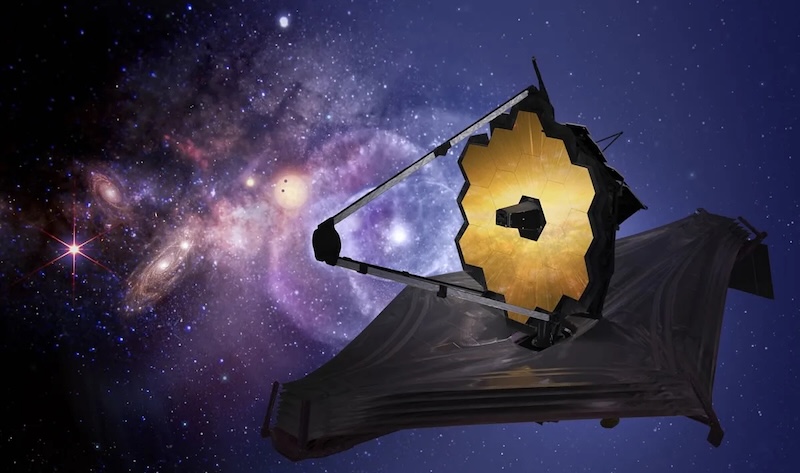- GJ 9827 d is an exoplanet orbiting a red dwarf star, some 98 light-years away. It’s about twice the size of Earth and searing hot.
- It’s the smallest exoplanet so far where water vapor has been detected. But does it have a hydrogen atmosphere, or a more Earth-like atmosphere?
- New results from the Webb space telescope suggest an atmosphere dense with heavy molecules. This includes even more water vapor than first thought, suggesting the hot planet is a “steam world.”
GJ 9827 d: Smallest exoplanet with water vapor found so far
GJ 9827 d is an exoplanet about twice the size of Earth, 98 light-years away. It’s the smallest exoplanet found so far with water vapor in its atmosphere. That’s a big deal in the search for planets similar to Earth. But is GJ 9827 d like Earth? It’s approximately twice Earth’s diameter. Does this exoplanet have a steamy atmosphere of mostly water vapor, which you might expect from a rocky Earth-like world? Or does it have a hydrogen atmosphere with just a little water vapor, indicating it’s what’s known as a mini-Neptune?
Now, researchers using the Webb space telescope have found that the atmosphere of GJ 9827 d has a lot of water vapor. They say this suggests it’s likely a “steam world,” with an atmosphere similar to rocky planets like Earth.
Caroline Piaulet-Ghorayeb at the University of Montreal’s Trottier Institute for Research on Exoplanets (IREx) and her colleagues published the peer-reviewed findings in The Astrophysical Journal Letters on October 4, 2024.
A water vapor atmosphere
Astronomers using the Hubble Space Telescope found evidence of water vapor on GJ 9827 d earlier this year. They suggested then it was either a super-Earth or mini-Neptune. Super-Earths are rocky planets larger than Earth but smaller than planets like Neptune. Although there aren’t any in our solar system, astronomers have found they are quite common elsewhere in our galaxy. Mini-Neptunes are larger with thick hydrogen atmospheres, but still smaller than Neptune.
Piaulet-Ghorayeb said:
For now, all the planets we’ve detected that have atmospheres are giant planets, or at best mini-Neptunes. These planets have atmospheres made up mostly of hydrogen, making them more similar to gas giants in the solar system than to terrestrial planets like Earth, which have atmospheres dominated by heavier elements.
Steam world exoplanet
But GJ 9827 d is different. Instead of hydrogen, Webb found its atmosphere is composed of heavier elements with abundant water vapor, more similar to planets like Earth. As Piaulet-Ghorayeb noted:
It’s closer in molecular weight to the carbon dioxide or nitrogen-rich atmospheres that we are currently looking for on smaller rocky planets, where we would eventually look for life.
The researchers used the Near-Infrared Imager and Slitless Spectrograph (NIRISS), a Canadian instrument on Webb, for their observations. They analyzed the light coming from the planet’s star as the planet transited – passed in front of – the star.
Then, the researchers combined the data from Hubble and Webb. This helped to confirm that the water vapor and other features seen in the spectrum were really in the planet’s atmosphere and not an error such as contamination data from the star.
The results support GJ 9827 d having a dense atmosphere with a lot of water.

Too hot for life as we know it
So, could GJ 9827 d be habitable? Unfortunately, that isn’t too likely. There may be a lot of water vapor, but it is probably hot steam, since the planet is so hot, about 660 degrees Fahrenheit, or 350 C. That’s because the planet orbits close to its star.
The findings, however, do show that smaller exoplanets can have atmospheres more like Earth’s than those of gas or ice giants. That in itself is an exciting discovery. As Piaulet-Ghorayeb said:
This is a huge step towards the goal of searching for atmospheres around smaller, terrestrial-like planets.
GJ 9827 d is the first planet where we detect an atmosphere rich in heavy molecules, just like the terrestrial planets of the solar system, and the first confirmed example in a long time of a “steam world” posited by the scientific community.
Bottom line: Astronomers using the Webb space telescope say that the hot exoplanet GJ 9827 d has more water vapor than first thought. They call it a steam world exoplanet.
Source: JWST/NIRISS Reveals the Water-rich “Steam World” Atmosphere of GJ 9827 d
Via University of Montreal
Read more: Astronomers find smallest exoplanet yet with water vapor
Read more: Water on exoplanets is mostly hidden deep inside